| Author |
Topic: Another 1935 National cast lap steel resurfaces |
Barry Fagan
From:
Columbus, Ohio, USA
|
 Posted 31 Aug 2014 9:43 am
Posted 31 Aug 2014 9:43 am |
|
I read with great interest Ralph Czitrom's thread, "my 1935 National adventure", which I found on the forum in an Internet search.
I purchased a dilapidated 1935 National lap steel guitar at a flea market in Fayette County, Ohio around 1980, & just hung it on the wall. (I play a little guitar & banjo but haven’t yet learned lap steel.) The Internet wasn’t around in 1980 so the only references to the instrument that I found back then were brief paragraphs in books on the history of the electric guitar. This past winter was so inhospitable in Ohio that I went back to some old projects that I had mothballed & one of them was to research the National. I was delighted to come across a thread on them on this site.
I now know that my example has been refinished (poorly) and that it is fairly complete, (the pickup components & tuning keys are photographed separately), but it’s missing the back plate & the back felt. I purchased it with a canvas gig bag, not a hardshell case.
The serial number is N162. This places it fairly early in the catalog of known National lap steel serial numbers in Mark Makin's excellent Palm Trees, Senoritas… And Rocket Ships!, although, I have no idea how many other examples may have surfaced since the publication date. I also note that on page 283 of the publication there's a brief biography on Lee Moore, a National lap steel guitar player originally from Circleville Ohio. (Circleville is about 10 miles from the Fayette County flea market where I bought the guitar.) I have a vain hope that the guitar I own actually may have belonged to Lee Moore, although he is depicted holding the later longer scale model in the book. The point here is that I plan to refinish it to "as original", unless I can determine that Lee Moore toured with it in its refinished state, in which case, I'd probably leave it as it currently is. I rather doubt I am going to get that level of detail about this particular instrument, but it's worth a try. The Internet turns up strange things.
I’m hoping to learn enough from other National enthusiasts to get it up & running, & have enclosed a few pictures of where the project is starting. Any help, or encouragement, would be appreciated.




 |
|
|
|
Paul Arntson
From:
Washington, USA
|
 Posted 31 Aug 2014 9:50 pm
Posted 31 Aug 2014 9:50 pm |
|
One thing I have always wondered: is the horseshoe magnet magnetized so both prongs are north (or south) or is it like a regular horseshoe magnet?
A quick test would be how does a nail stick to it?
_________________
Excel D10 8&4, Supro 8, Regal resonator, Peavey Powerslide, homemade lap 12(a work in progress) |
|
|
|
Kelvin Monaghan
From:
Victoria, Australia
|
 Posted 31 Aug 2014 11:35 pm
Posted 31 Aug 2014 11:35 pm |
|
Its a regular horseshoe ,north one pole south the other each coil sits on the end,very very basic and fairly weak output.
Usually wired in series kinda humbucking. |
|
|
|
Noah Miller
From:
Rocky Hill, CT
|
 Posted 1 Sep 2014 3:42 am
Posted 1 Sep 2014 3:42 am |
|
| Interesting; the aluminum Nationals I've owned both had single-coil pickups, albeit with the same magnet. This humbucking design appears to have been taken directly from the Dobro All-Electric, which was a few years old when the aluminum steels were introduced. I wonder if they started with the humbucker but changed to a single coil to reduce costs. |
|
|
|
Rick Aiello
From:
Berryville, VA USA
|
 Posted 1 Sep 2014 5:04 am
Posted 1 Sep 2014 5:04 am |
|
| Kelvin Monaghan wrote: |
Its a regular horseshoe ,north one pole south the other each coil sits on the end,very very basic and fairly weak output.
Usually wired in series kinda humbucking. |
Those must be the real old ones ... I've remagged a bunch, and they all had both flanges as one pole ... And the "U" the other pole ...
Having each flange a different pole is a terrible "magnetic plan" ... The lines of force would run through the blade ( IE a keeper) .... Or jump the tiny air gap if the two blades didn't physically touch ... So very few lines of force would get up to string level ...
They must have figured that out on the later ones  |
|
|
|
Mark Makin
From:
Nottingham, UK
|
 Posted 1 Sep 2014 6:36 am
Posted 1 Sep 2014 6:36 am |
|
| Hi Barry, that looks like a good project to while away the winter months. I wish you well with it. Best Mark. |
|
|
|
Kelvin Monaghan
From:
Victoria, Australia
|
 Posted 1 Sep 2014 2:48 pm
Posted 1 Sep 2014 2:48 pm |
|
I also have Tutmarc Serenader with the same type of arrangement,big horseshoe ,it also has North,South poles to each coil.
When playing the 3rd and 4th strings the output is lower and a kinda phasing can be heard ,not a great setup. |
|
|
|
Barry Fagan
From:
Columbus, Ohio, USA
|
 Posted 1 Sep 2014 3:53 pm
Posted 1 Sep 2014 3:53 pm |
|
Yeah, I suspect the human race has managed to make some progress in electromagnetic pickup design in the ensuing 79 years since this style was produced. Still, the owners who have working examples of this guitar seem to be pretty satisfied with the tone & output from the other comments I read.
To expand on Paul Arntson's & Kelvin Monaghan's comments, one end of one of the legs of the "U" is marked with an "N" in a circle that presumably denotes the north pole. A nail sticks everywhere except at the bottom of the "U".
Now, does anyone have any suggestions on how to get the thing functional again? |
|
|
|
Kelvin Monaghan
From:
Victoria, Australia
|
 Posted 1 Sep 2014 4:18 pm
Posted 1 Sep 2014 4:18 pm |
|
Barry,that sounds the way it should be ,one pole will be the North the other the South,each coil goes to each magnet end usually wired series and away you go ,as i said a very simple design. You can check with a compas or if you have another guitar place each end of the Horseshoe over the pickup one end should repel the other should attract.
Cheers |
|
|
|
Ralph Czitrom
From:
Ringwood, New Jersey
|
 Posted 1 Sep 2014 4:52 pm
Posted 1 Sep 2014 4:52 pm |
|
| Barry - When I started my project, I consulted with Jason Lollar who as I'm sure you know, along with Rick Aiello, is one of the Zen masters of pickups. I sent him what I had (it was a complete unit, though not functional) and Jason put it back in good working order. It's very crude, with two blades which are manually adjustable. That may be the best way to go, if Jason is accepting specialty orders. I agree with Mark about the rest of the instrument. It was a very rewarding project. My National is a conversation piece, for sure, and a very playable instrument! Good luck. |
|
|
|
Barry Fagan
From:
Columbus, Ohio, USA
|
 Posted 1 Sep 2014 7:00 pm
Posted 1 Sep 2014 7:00 pm |
|
Kelvin - I tried testing polarity with several magnets. The field is so weak on the National horseshoe that there is attraction to the base metal from the other magnet, slightly modulated by the residual polarity. (It never rises to the point of repulsion, just greater & lesser attraction.) Looks like my best better is to chase down a compass.
Ralph - You've been down this road before. Can you tell from the photo if I am missing any pickup components, before I try to send it out for rebuilding? I gather from Rick's comments that there may have been a running change from two coils to one coils pickups at some point in the manufacture of the guitar. Do I gather that your N363 has two coil pickup from your original post? |
|
|
|
Ralph Czitrom
From:
Ringwood, New Jersey
|
 Posted 2 Sep 2014 6:09 am
Posted 2 Sep 2014 6:09 am |
|
| Barry - Mine definitely has two coils, though I don't have much knowledge or understanding of the mysteries of guitar pickups, preferring to leave that to the experts. If it's any help, I learned that in rewinding the pickup, Jason instructed that mine should have 10,000 turns using #38 wire. |
|
|
|
Barry Fagan
From:
Columbus, Ohio, USA
|
 Posted 2 Sep 2014 7:39 am
Posted 2 Sep 2014 7:39 am |
|
Thank you, Ralph, for the quick reply! (I also sent you a PM early today, but you essentially answered my questions in the post.) In studying the photographs of the pickup cavity of your instrument, it appears to me that the horseshoe magnet is resting on 2 charcoal-colored rectangular blocks that may be made of wood or felt. Can you comment? These are not evident on a comparable photo from Raymond Jones's 1939 model also posted in the same thread. His magnet sits on 3 lugs cast into the inside of the cavity. There are no lugs cast in my guitar, & I suspect that I am missing the supports for the horseshoe. Do you have any details on material, dimensions & placement for these items?
While I am pumping you for information... The back plate is missing from my instrument. Is yours cast aluminum, or another material? The photo in your post suggests that it is attached with a single standard-slot (not Phillips) screw. Is that the case?
Lastly, my instrument appears to have the initials "RV" penciled in the control cavity, as visible in the close-up photo in my original post. Any initials in yours? As you probably know, old Fender electrics are marked internally with the workers' initials as part of quality control.
Sorry for bombarding you with questions. Its just that I've had 34 years of ownership to think them up before I realized that anyone else owned an example. If its easier to talk than type, I can send you my cell #. I'm on Eastern time. I'd love to hear from other owners & experts also. |
|
|
|
Barry Fagan
From:
Columbus, Ohio, USA
|
 Posted 1 Oct 2014 4:54 pm
Posted 1 Oct 2014 4:54 pm |
|
Hi Mark!
Thank you very much for the reply. At the advice of Ralph Czitrom (nice guy), I sent my pickup off to Jason Lollar in Tacoma, WA, where it is currently "in the queue" to be rebuilt. Ralph sounded very pleased with Jason's work. He certainly is prompt in answering his emails, which is an improvement on some of the repair people I've written in the past.
Thanks also for the serial number info. I've written Mark Makin, to see if more of these instruments have resurfaced since his book was published, but I haven't yet heard back.
My guitar is painted red (poorly) & probably shouldn't be. Assuming that yours is the original color, are the silver parts painted silver, are they polished aluminum, or something else? Also, what color is the felt on the back - mine's completely gone, as is the back cover plate. Again, thank you for writing.
Barry |
|
|
|
Lee Holliday
From:
United Kingdom
|
 Posted 3 Oct 2014 1:11 pm
Posted 3 Oct 2014 1:11 pm |
|
I had one that had an original red translucent finish that I got from George Gruhn back in the 90s when he used to issue the little booklets.
 |
|
|
|
Lee Holliday
From:
United Kingdom
|
 Posted 3 Oct 2014 1:17 pm
Posted 3 Oct 2014 1:17 pm |
|
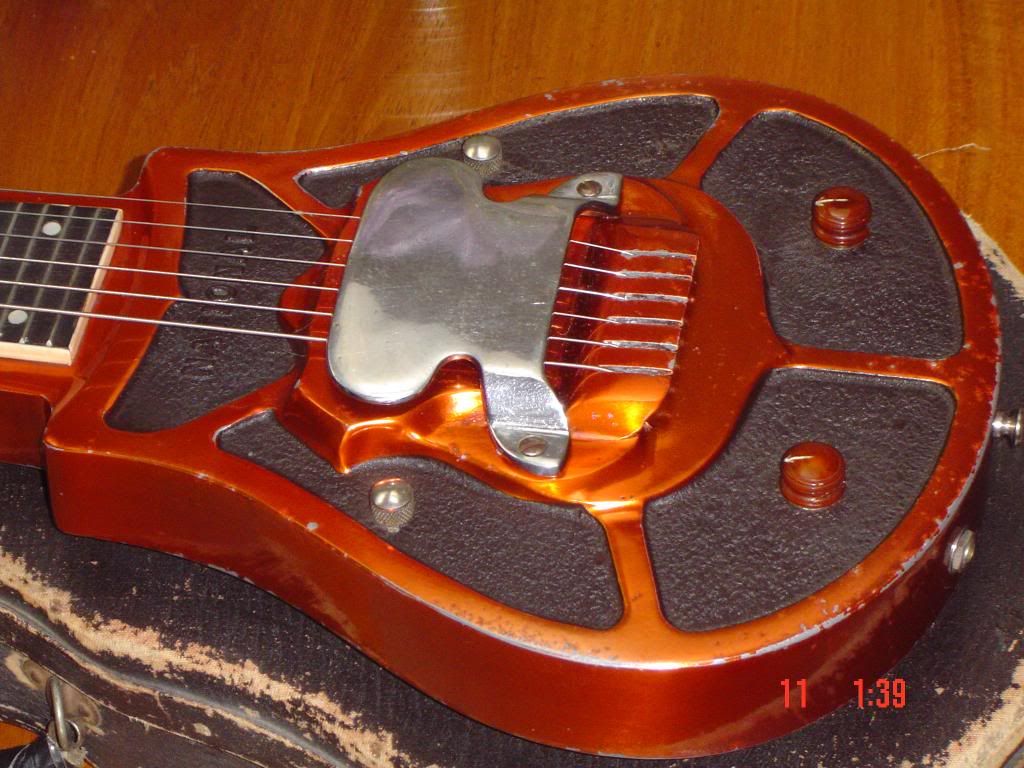
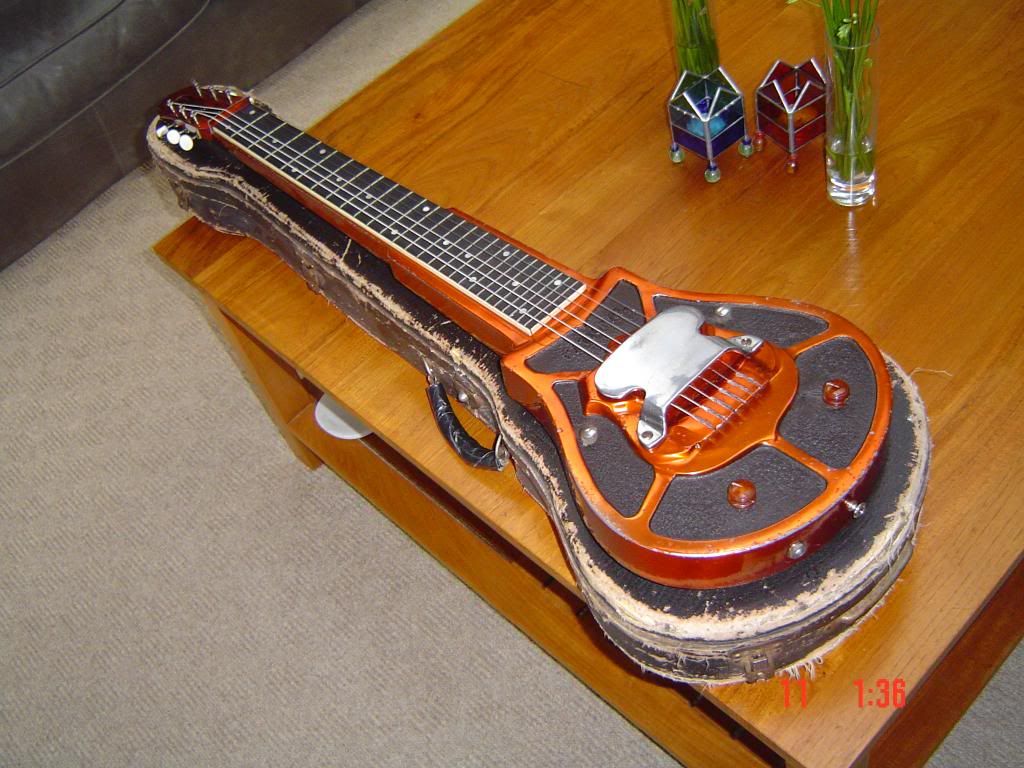
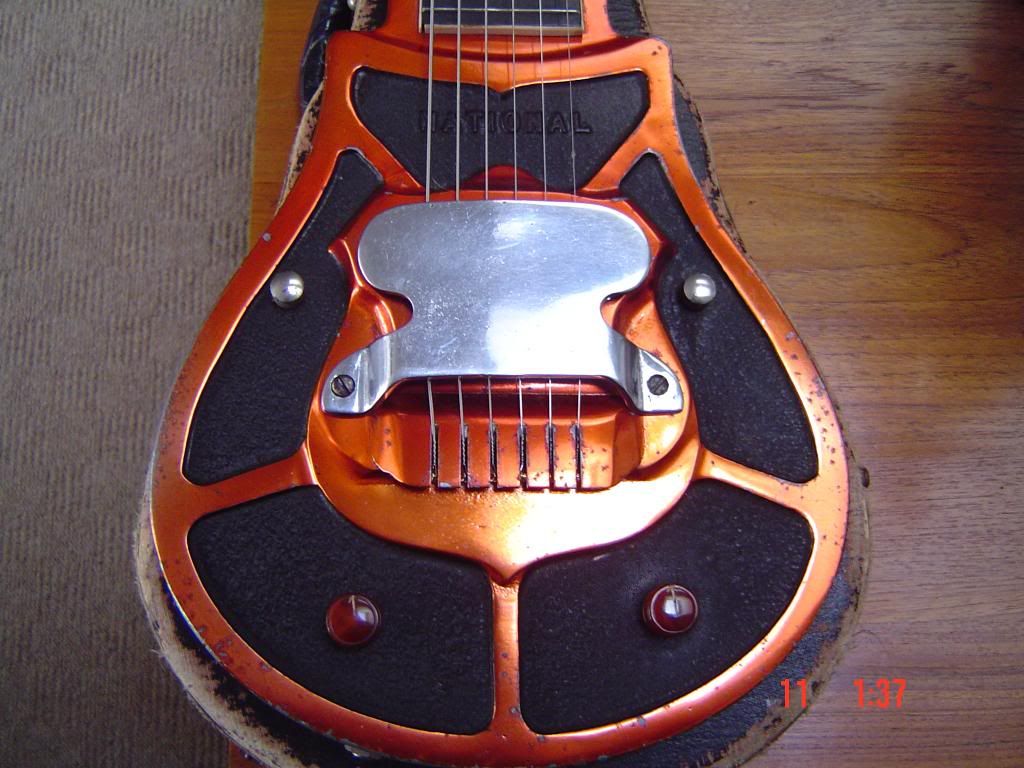
And a few more, I sold this one probably ten or so years ago so hopefully the finish is still as you see it, although the tone & volume knobs were very brittle and for day to day use a set of chrome domes were a better option. Lee |
|
|
|
Barry Fagan
From:
Columbus, Ohio, USA
|
 Posted 3 Oct 2014 5:02 pm
Posted 3 Oct 2014 5:02 pm |
|
Thank you for the reply Lee! This represents a new development! The quality of the paint job on my instrument is fairly poor, with some red paint streaked on the white fretboard binding (can't call it overspray, as it doesn't look like it was sprayed, more like it crept in under masking tape), & drips on the back. (Visible on the photos in my original post, although, of course, it would have been covered by the felt backing.)I don't have the sense as to whether this was 'factory' or an 'owner update'.
Can anyone else weigh in on the subject? |
|
|
|
Barry Fagan
From:
Columbus, Ohio, USA
|
 Posted 3 Oct 2014 5:03 pm
Posted 3 Oct 2014 5:03 pm |
|
Very nice looking collection of instruments, by the way, Lee.
Barry |
|
|
|
Lee Holliday
From:
United Kingdom
|
 Posted 4 Oct 2014 1:01 am
Posted 4 Oct 2014 1:01 am |
|
I must put together an updated photo as the Mandolin, the cast National are now gone but other lodgers have moved in! The Dobro on the far right is in pieces awaiting a respray & a new fingerboard.
I will stage a new photo shoot later in the week which may show where my interests are now.
The Red national had a translucent finish, the best way I can described it is like a toffee apple.
I have some close up photos of a greenish grey one that I had later, it is effectively the same translucent but Greenish grey.
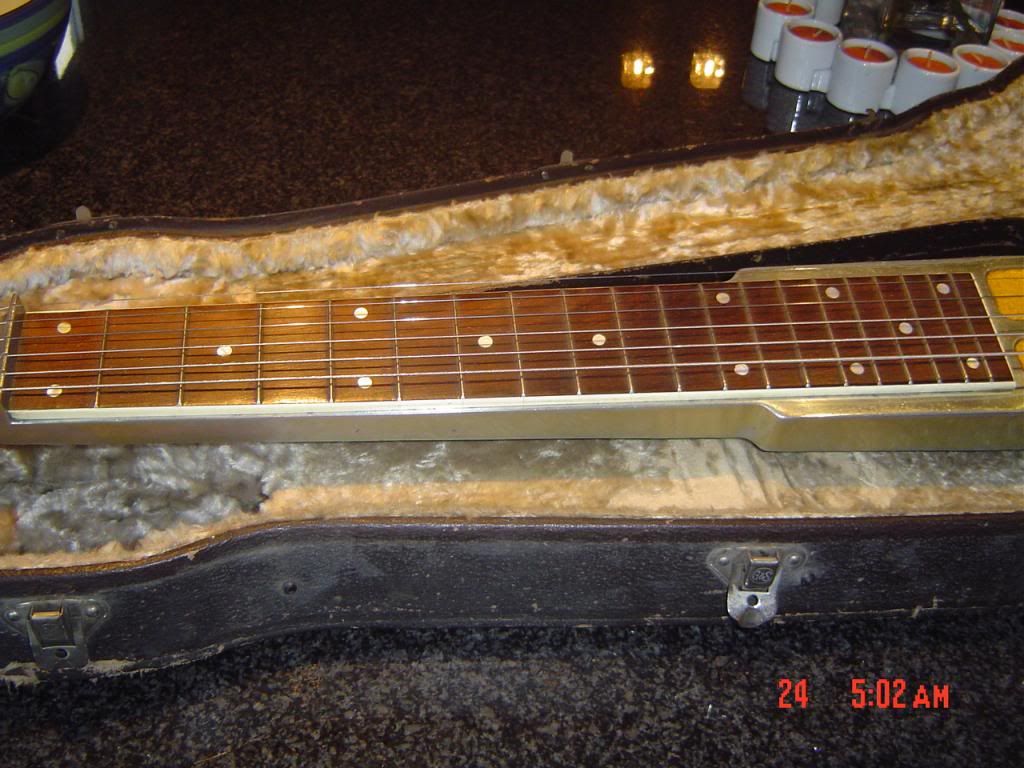
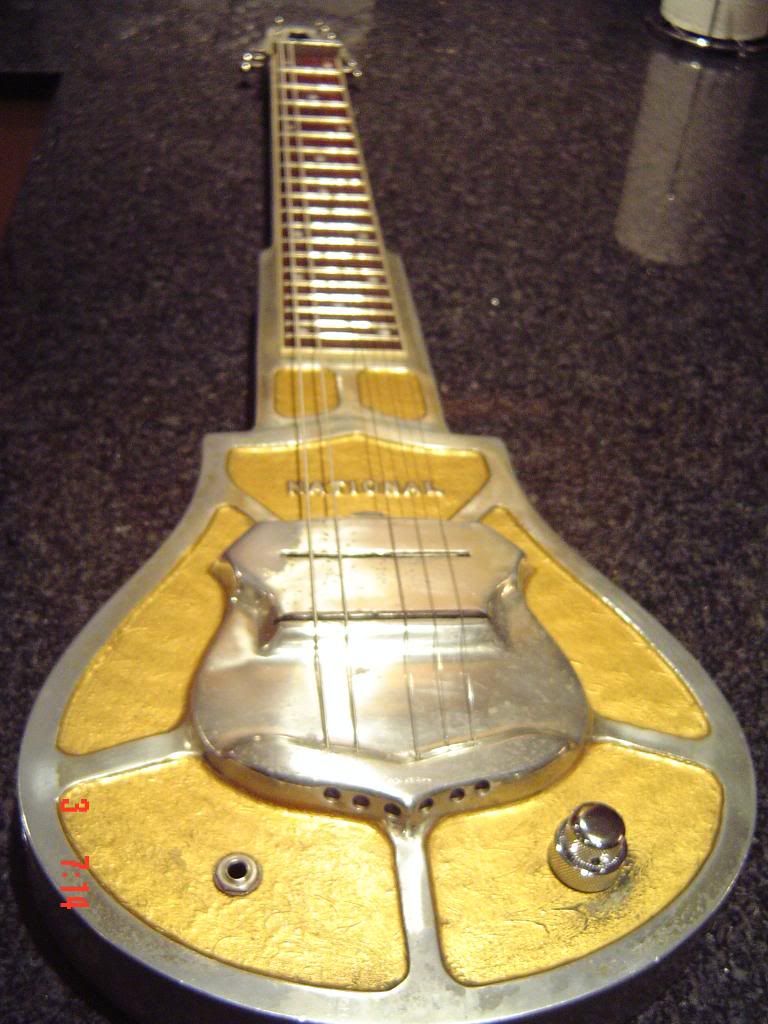 |
|
|
|
Barry Fagan
From:
Columbus, Ohio, USA
|
 Posted 4 Oct 2014 10:40 am
Posted 4 Oct 2014 10:40 am |
|
This just adds to the complexity, LOL. I find it hard to discern true color from a computer monitor, but I wonder if your Greenish grey color is the silver color, but with oxidation of the pigment or yellowing of a lacquer overcoat. Certainly, the gold colored recesses appear darker to me in the photos. This is obviously an earlier instrument, with the shorter fretboard, non-adjustable pick-up height & single volume control.
Do you happen to recall the serial number of this one? I'm sort of collecting them to forward on to Mark Makin.
As an unrelated comment, I note that your cast Nationals & many others I've seen have a hardshell case. Mine came with a canvas 'gig bag' which I'm assuming is also original, as it's not shaped to fit anything else.
I'm looking forward to seeing your updated 'family photo'.
Barry |
|
|
|
Alan Brookes
From:
Brummy living in Southern California
|
 Posted 4 Oct 2014 2:59 pm
Posted 4 Oct 2014 2:59 pm |
|
| Barry Fagan wrote: |
| ...Mine came with a canvas 'gig bag' which I'm assuming is also original, as it's not shaped to fit anything else... |
They probably thought at the time of manufacture that a cast iron instrument wouldn't need to be safeguarded as much as the wooden acoustic instruments that they were selling, so a soft bag would be adequate. When I was a student I carried around a jumbo guitar in a gig bag everywhere I went, and it never suffered any damage. Fifty years later I still have it, and it's still in the same gig bag. 
I was looking at that instrument of yours and thinking how I would go about refinishing one like it. The best way seems to be to make cardboard cutouts that exactly fit the recessed areas, remove the cutouts, spray the area with satin-finish paint, leave it to completely dry, insert the cutouts and then spray the other color. Then, when the main color is completely dry, remove the cutouts. Or, instead of cutouts you could use strips of masking tape, cut to size and shape. If you do that, use the special masking tape they make for painters, as it doesn't allow paint to leak around the edges.
The only other way would be to paint by hand. |
|
|
|
Lee Holliday
From:
United Kingdom
|
 Posted 5 Oct 2014 1:59 am
Posted 5 Oct 2014 1:59 am |
|
I will look to see if I have the serial number although I may have already given it to Mark at the time, I sold that one to Gwyn Ashton who is a good pro player based in the UK, I meant to mention that I replaced the lone volume pot on that one with a stacked tone & Volume pot which you will find gives the nasty or sweet option on sound. You have the option to drill another hole in the process of the refurbishment.With just the volume pot they do not fulfil there full potential.
If it was me I would strip it all apart, fingerboard off so as there is just the aluminium body, get it bead blasted, then buffed prior to restoring the laquer finish (gold would be my choice) and get the inserts done black as Rick Aielio has recently done with his new guitar & Amp.
Don't rush it and keep us up to date.
Lee |
|
|
|
Barry Fagan
From:
Columbus, Ohio, USA
|
 Posted 5 Oct 2014 6:06 am
Posted 5 Oct 2014 6:06 am |
|
Thank you Alan & Lee for your thoughts. Ralph Czitrom told me that the gold paint sold for plastic models in small jars is an exact match for the original finish on his. Refinishing may be as simple as applying the base coat, painting gold in the cavities by hand with a small brush as Alan suggested, then wiping off the excess from the flat surfaces with a rag-covered finger before it dries.
My main goal here it to preserve the guitar's history, & make sure that I'm not removing a factory finish to apply something that wasn't there originally. If the red finish was a late, owner-applied modification, then I'll take it back to "original". (See also my far-fetched musing re Lee Moore in my original post at the top.)
Lee Holliday's red guitar in his first reply 'complicates' things a bit - perhaps this color was a later styling change at the factory. My serial number seems awfully early for this, although I'm aware from research in my car hobby that products don't always come out of the factory in serial number order. I also suppose it's possible that National could have offered a choice of colors in 1935, but I would think that have been mentioned in the sales literature. I'll up load some pictures of the painting errors on my guitar that make me think that it was an amateur modification. Anyone else out there with a factory red National cast lap steel?
Alan, I'll upload a few pictures of the gig bag, too. Most everyone else seems to have a hardshell case.
Lee, I like the idea of a stacked volume/tone control through the single original hole. That conserves the instrument & allows return to original in the future. Philosophically, I feel that I don't actually 'own' these instruments but that I am their temporary caretakers. They were around before I was & I'm hoping that they will be around, unaltered, after I'm gone. Using a stacked control allows the best of both worlds - increased playablity now & reversion to as-manufactured in the future. Thank you again for your replies! |
|
|
|
Barry Fagan
From:
Columbus, Ohio, USA
|
 Posted 5 Oct 2014 6:23 am
Posted 5 Oct 2014 6:23 am |
|
As promised, here are the photos. Now that I study the gig bag critically, I'm not so sure that it's unique to the instrument - the shape may also fit a parlor guitar.
The other 2 photos show the runs in the paint & the paint on the fretboard binding.



 |
|
|
|
Lee Holliday
From:
United Kingdom
|
 Posted 5 Oct 2014 9:01 am
Posted 5 Oct 2014 9:01 am |
|
Barry the give away with your refinished guitar is that the backs were originally plain aluminium to be covered with wooly felt which from mine I removed and hand polished on both of mine as it was tatty to say the least.
I have a supro at the moment that has this intact, also the soft case option was the one that I have with this one.
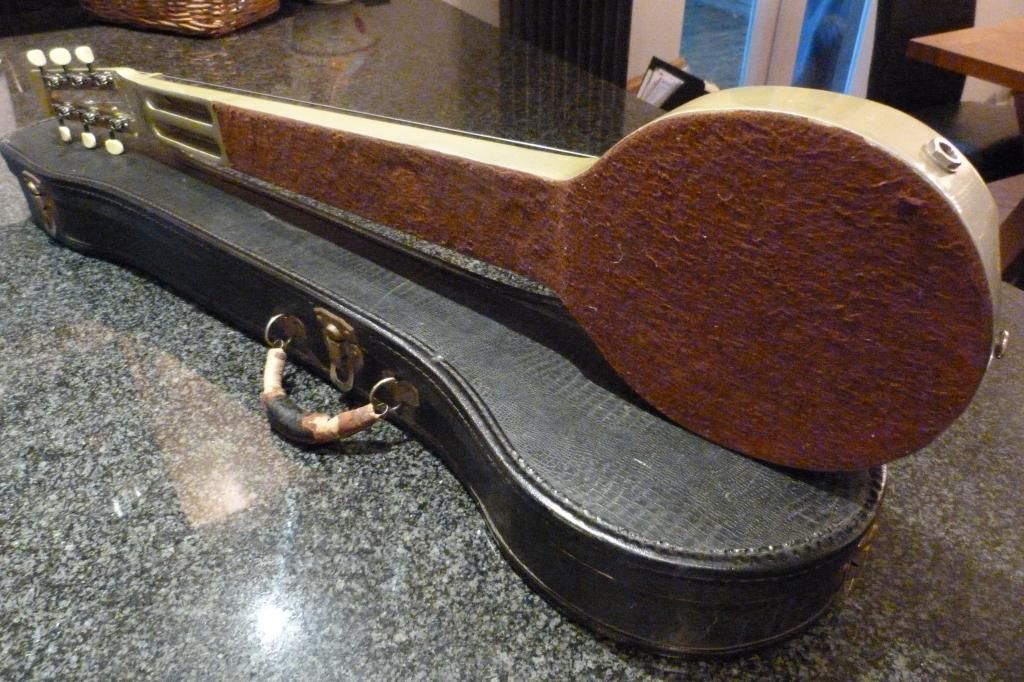
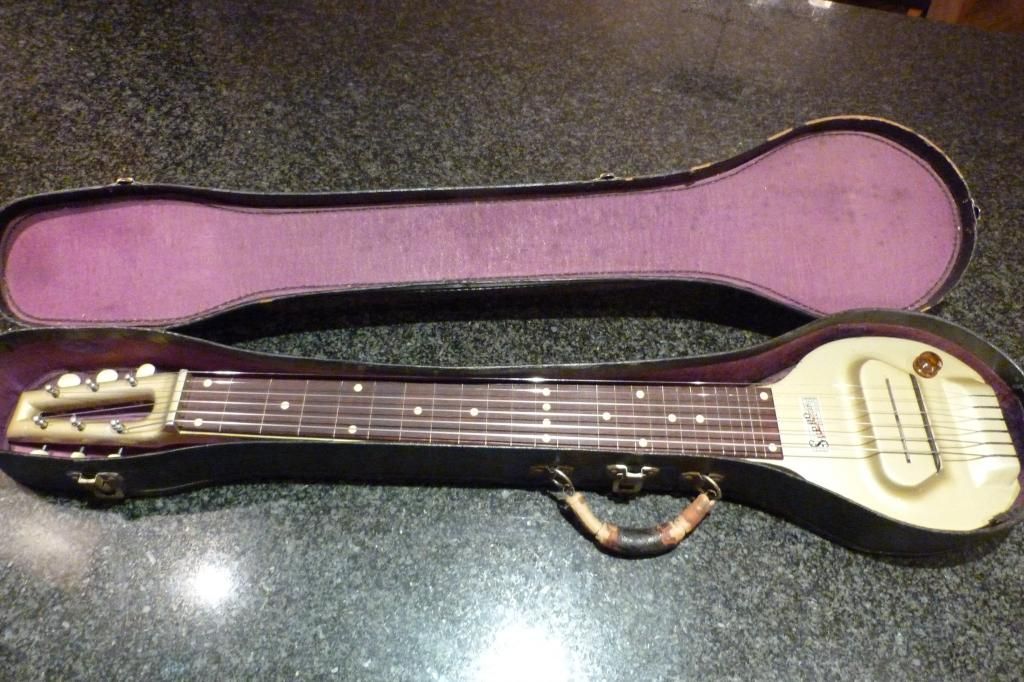 |
|
|
|



